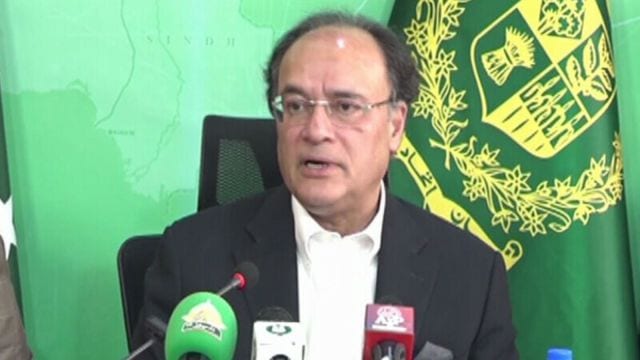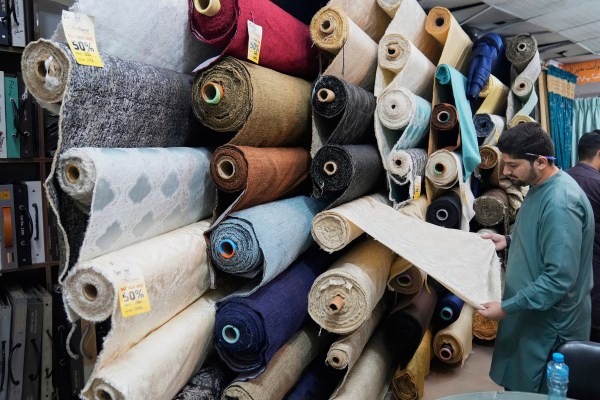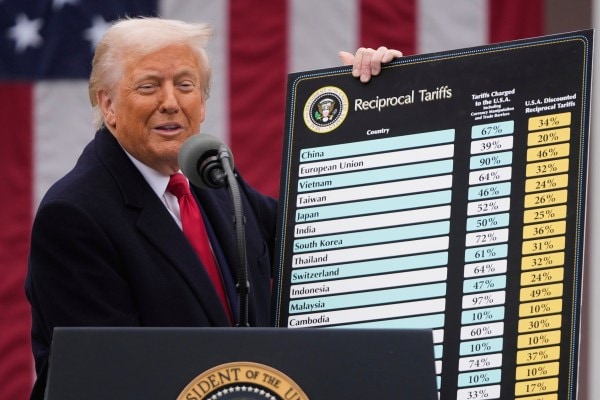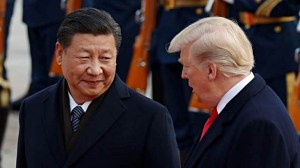‘Never let a good crisis go waste’: Pakistan sees silver lining amid 29 per cent US tariffs on country’s exports
The sweeping tariff hits Pakistani exports harder than those in neighbouring New Delhi, exposing a major Achilles’ heel in its vital textile sector.
 Pakistan's Finance Minister Muhammad Aurangzeb speaks at a press conference in Islamabad on Saturday (X)
Pakistan's Finance Minister Muhammad Aurangzeb speaks at a press conference in Islamabad on Saturday (X)United States President Donald Trump’s decision to impose a 29 per cent tariff on Pakistani exports has sparked alarm across the country’s economic and political corridors. However, responding to the tariffs on Saturday, Pakistan Finance Minister Muhammad Aurangzeb said that the country was looking at them as an opportunity to negotiate “balanced economic relationships”.
“You should never let a good crisis go to waste,” Aurangzeb said in a press conference, adding, “This isn’t just about the tariffs. It’s about using the moment to negotiate smarter and build more balanced economic relationships”
The sweeping tariffs hit Pakistani exports harder than those in neighbouring New Delhi, exposing a major Achilles’ heel in its vital textile sector. As per a report by Dawn, in the first seven months of FY 2024-25, Pakistan exported $3.6 billion worth of goods to the US — accounting for 19% of its total exports — with textiles and apparel comprising 79 per cent($2.8 billion) of that figure.
Notably, 94 per cent of these textile exports are value-added items such as garments and home textiles. Despite this, Pakistan already faces tariffs of up to 17 per cent on these products, while its cotton imports from the US continue to enter duty-free.
If President Trump’s proposed tariffs are enforced, Pakistan’s $6 billion export market to the US could face a severe blow — likely putting downward pressure on the rupee, driving up import costs, and widening a trade deficit that is already expanding by 4% each month. It will also threaten jobs, margins, and overall competitiveness.
Yet officials in Islamabad say the challenge may also pave the way for deeper negotiations and longer-term economic gains bringing ‘a win-win situation for both Pakistan and the US’.
High-level response to a high-stakes challenge
In a swift response, Pakistan’s Prime Minister Shehbaz Sharif has set up two key bodies to coordinate Pakistan’s strategy. The first, a steering committee led by Finance Minister Muhammad Aurangzeb, brings together policymakers, economists and industry voices. A second working group chaired by the Secretary of Commerce has been tasked with producing actionable recommendations to mitigate the fallout.
As per a report by PTI, a senior delegation from Islamabad is expected to visit Washington before April 9, when the tariffs officially take effect, to present what officials describe as a “structured, mutually beneficial” proposal to the Trump administration.
 A vendor displays linen sofa fabric in a house linens store at a market in Lahore, Pakistan, Thursday, April 3, 2025. (AP Photo/K.M. Chaudary)
A vendor displays linen sofa fabric in a house linens store at a market in Lahore, Pakistan, Thursday, April 3, 2025. (AP Photo/K.M. Chaudary)
“Our focus is on structural reforms and strategic dialogue,” Aurangzeb said. “This is a moment to push for export diversification, strengthen our tax base, and demonstrate macroeconomic stability,” he added.
Aurangzeb also highlighted that the crisis could ultimately be turned into an opportunity for Pakistan to upgrade its trade framework.
“We want to make sure that we, in terms of our representations, put forward how we see it in the medium to long term as a win-win situation for both Pakistan and the US,” he added.
Pakistan vs India: Uneven tariff burdens
Trump’s latest wave of tariffs has dealt a sweeping blow to Asian economies, with manufacturing-heavy nations taking the hardest hit. While Western allies like the UK and EU were slapped with 10–20 per cent tariffs, Trump’s primary focus remained on Asia — the nerve centre of the global supply chain.
China bore the brunt, facing a fresh 34 per cent levy that pushed the effective US tariff rate on Chinese goods to a record 54 per cent — the highest ever. India, despite ongoing trade negotiations, was not spared either and was hit with a steep 27 per cent tariff. Other regional players also caught in the crossfire include Thailand (36 per cent), Indonesia (32 per cent), Laos (48 per cent), Vietnam (46 per cent) and Pakistan (29 per cent).
Amid the upheaval, some see opportunity — especially for New Delhi. Former trade officer and GTRI head Ajay Srivastava told The Indian Express that the tariff realignment “creates a natural competitive advantage” for Indian manufacturers. “With a lower 27 per cent tariff on Indian goods compared to 54 per cent on China and 37 per cent on Bangladesh, India can gain market share, especially in textiles and garments,” he noted. “The high tariffs on Chinese and Bangladeshi exports create space for Indian manufacturers to attract production and boost exports.”
 President Donald Trump speaks during an event to announce new tariffs in the Rose Garden at the White House, Wednesday, April 2, 2025, in Washington. (AP Photo/Mark Schiefelbein)
President Donald Trump speaks during an event to announce new tariffs in the Rose Garden at the White House, Wednesday, April 2, 2025, in Washington. (AP Photo/Mark Schiefelbein)
With nearly 80 per cent of its exports to the US coming from textiles and apparel, the tariffs could significantly impact Pakistan’s revenues, employment, and competitiveness.
Still, Islamabad sees a potential silver lining. Given that Pakistan accounts for just 0.15 per cent of total US imports, it is not a primary target of the trade offensive. Trump’s gaze is firmly set on economies like China, India, and Vietnam — countries with large trade surpluses and exports spanning sensitive sectors such as steel and aluminium, where Pakistan has little presence.
Additionally, inflation in Pakistan recently hit a six-decade low at 0.7 per cent, and the tax-to-GDP ratio has risen to 10.6 per cent. These macroeconomic improvements provide a platform for negotiation — and perhaps, a cushion against immediate fallout.
A bulletin from US Customs and Border Protection clarified that goods already en route to the US before the April 6 deadline will be exempt — but only if they arrive by 12:01 am ET on May 27.
Countries like the UK, Colombia, Argentina, and Saudi Arabia are also on the tariff list, but few face as acute an impact as Pakistan due to its concentrated export structure.
However, Islamabad hopes that by framing its case strategically — emphasising mutual economic benefits and political goodwill — it can extract concessions and perhaps even reposition itself within the global trading system. As one government adviser put it, “The game is changing. Pakistan can either brace for impact or try to shape the outcome. We’re choosing the latter”.
Must Read
Buzzing Now
Apr 09: Latest News
- 01
- 02
- 03
- 04
- 05

























